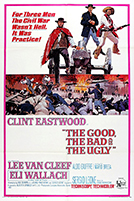The Good, the Bad and the Ugly

| Original title: | l Buono, il brutto, il cattivo |
| Director: | Sergio Leone |
| Release: | Cinema |
| Running time: | 161 minutes |
| Release date: | 20 december 1967 |
| Rating: |
Mulder's Review
Sergio Leone's masterpiece The Good, the Bad and the Ugly is renowned for its cinematic brilliance and artistic daring. Set against the tumultuous backdrop of the American Civil War, this film transcends simple narrative and rises to the level of a timeless work of art. From its conception to its unforgettable climax, Leone's masterpiece shakes up conventions, defies expectations and redefines the very essence of the Western genre.
Leone's bold vision embraces the vast landscapes of the West, transforming them into a character as important as any flesh-and-blood protagonist. The camera traverses vast deserts, capturing not only the physical terrain but also the emotional battlefield on which our characters engage. The unforgiving yet haunting landscapes reflect the protagonists' internal struggles, their journeys reflected in the arid expanse.
A triumph of character-driven storytelling, The Good, the Bad and the Ugly boasts a cast that defies convention and delivers performances of unparalleled depth. Clint Eastwood, a man of few words but imposing presence, takes the helm as the man with no name. His stoic demeanor serves as a counterweight to the enigmatic Tuco, played with captivating dynamism by Eli Wallach. Lee Van Cleef, as the malevolent Angel Eyes, weaves a tapestry of villainy as intriguing as it is repulsive. These characters, seemingly bound by avarice, are all in search of stolen Confederate gold, setting off an explosive adventure full of betrayal and moral ambiguity.
Leone's cinematic technique defies conventional narrative, using parallel editing to create a symphony of interconnected narratives. Scenes flow seamlessly from one point of view to the next, weaving a complex tapestry of suspense, deception and revelation. In the iconic standoff scene, Leone masterfully uses silence and visual tension to create an electrifying climax that remains etched in cinematic memory.
Ennio Morricone's music is a character in its own right, a haunting melody that permeates the very essence of the film. The music, both evocative and rousing, serves as an emotional chorus, reinforcing the intensity of every scene. Morricone's compositions, in particular the haunting The Ecstasy of Gold, evoke a visceral response to the story.
The Good, the Bad and the Ugly is not just a Western; it's a profound exploration of human nature, morality and the inexorable forces that shape destinies. Leone navigates the vast spectrum of human emotions, dissecting notions of good and evil, heroism and betrayal, with an incisive, unconventional approach. The characters, far from being mere archetypes, are transformed into complex entities whose motivations transcend any simple categorization.
Beyond its thematic depth, the film demonstrates Leone's ability to blend the epic with the intimate. Vast panoramas are juxtaposed with close-ups of the characters, whose expressions reveal the depth of their internal struggles. Leone's skill lies not only in the grandiose spectacles, but also in the quiet moments, the unspoken gestures that amplify the emotional resonance.
Despite initial critical skepticism, The Good, the Bad and the Ugly has undeniably earned its place in the pantheon of great films. Leone's audacity in defying convention and pushing the boundaries of storytelling forged a legacy that endures, inspiring generations of filmmakers to embrace innovation and artistic risk.
As the dust settles on this cinematic journey, The Good, the Bad and the Ugly remains a testament to the power of imagination, the triumph of artistic vision and the profound impact of storytelling. Leone's opus elevates the Western genre to new heights, drawing audiences into a world where boundaries blur, morality is malleable and the quest for gold reveals the depths of human ambition and fragility. This is not just a film, but a visual and aural symphony that continues to resonate, inviting us to explore the vast expanse of human experience.
The Good, the Bad and the Ugly
Directed by Sergio Leone
Written by Age & Scarpelli, Luciano Vincenzoni, Sergio Leone
Story by Luciano Vincenzoni, Sergio Leone
Produced by Alberto Grimaldi
Starring Clint Eastwood, Eli Wallach, Lee Van Cleef, Aldo Giuffrè, Antonio Casas, Rada Rassimov, Aldo Sambrel, Enzo Petito, Luigi Pistilli, Livio Lorenzon, Al Mulloch, Sergio Mendizábal, Molino Rojo, Lorenzo Robledo, Mario Brega
Cinematography : Tonino Delli Colli
Edited by Nino Baragli, Eugenio Alabiso
Music by Ennio Morricone
Production companies : Produzioni Europee Associate, United Artists
Distributed by Produzioni Europee Associate, Park Circus France (France)
Release date : 23 December 1966 (Italy), December 20, 1967 (United States), March 8, 1968 (France)
Running time : 161 minutes
reviewed on October 11, 2009
Mulder's Mark:

